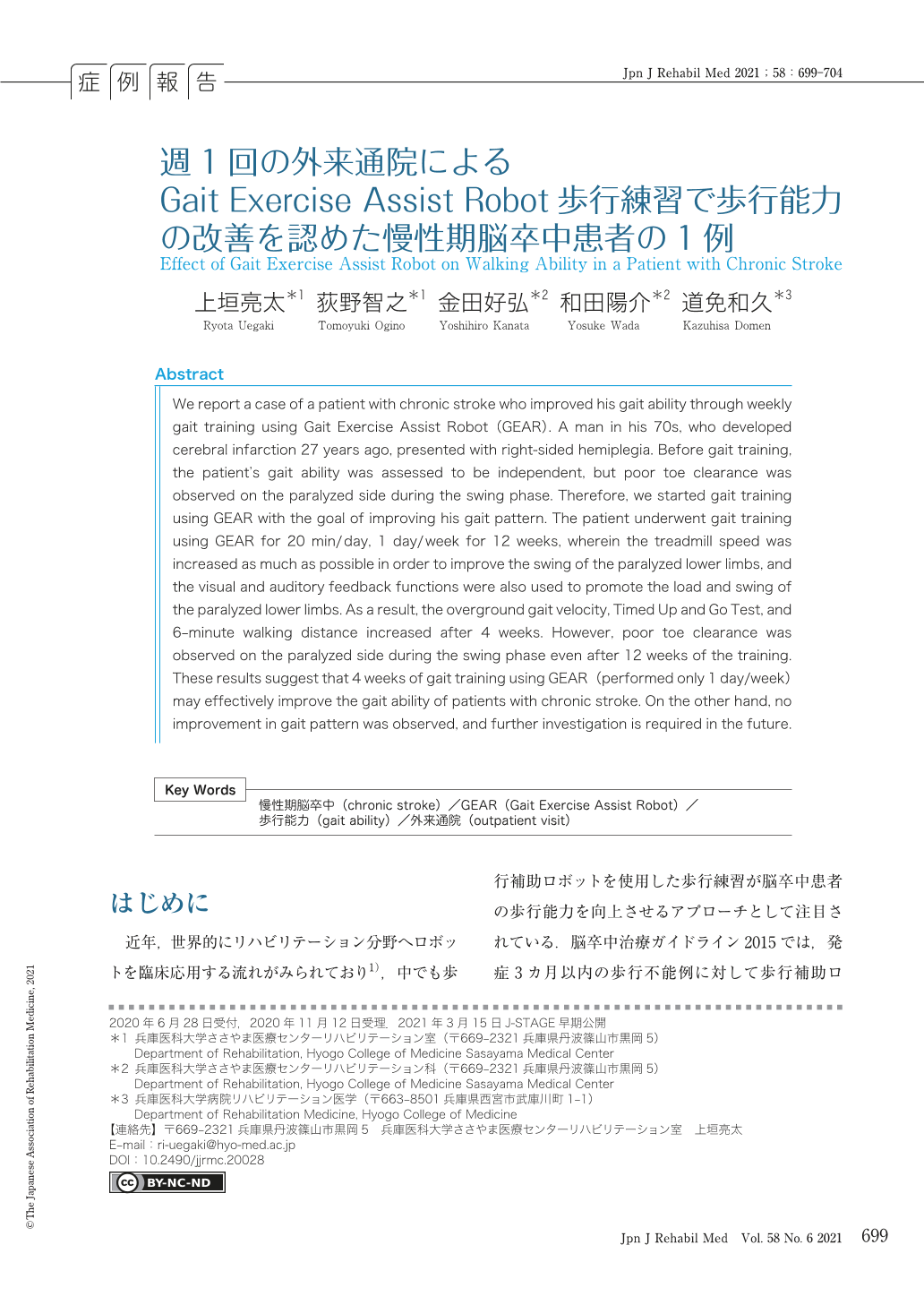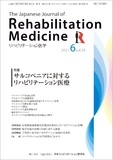Japanese
English
- 販売していません
- Abstract 文献概要
- 1ページ目 Look Inside
- 参考文献 Reference
はじめに
近年,世界的にリハビリテーション分野へロボットを臨床応用する流れがみられており1),中でも歩行補助ロボットを使用した歩行練習が脳卒中患者の歩行能力を向上させるアプローチとして注目されている.脳卒中治療ガイドライン2015では,発症3カ月以内の歩行不能例に対して歩行補助ロボットによる歩行練習を推奨している(グレードB)2).また,2017年にアップデートされたCochrane reviewにおいても,脳卒中患者に対してロボットなどの電気機械的アシスト下での歩行練習を併用するほうが歩行自立度が高くなることを報告している3).
歩行練習アシスト(トヨタ自動車株式会社,Gait Exercise Assist Robot〔GEAR〕)は,トヨタ自動車株式会社と藤田医科大学が共同で開発した練習支援型リハビリテーションロボットである(GEAR後継機の「ウェルウォークWW-1000」は,医療機器として承認され2017年秋よりレンタル開始しており,さらに2020年には新たに改良された「ウェルウェークWW-2000」が販売開始となっている).GEARは長下肢装具の利点である立脚支持性と短下肢装具の利点である遊脚容易性を備えた精緻な麻痺肢運動の補助実現を意図して設計されている.さらに充実したフィードバック性を有しており,視覚フィードバックとしてフィードバックモニタに全身像(鏡像),足元像を表示できるほか,音声フィードバックとして,膝折れ,荷重成功などの提示が可能である(図1,2)4).
GEARの効果としては,従来装具を使用した歩行練習よりも亜急性期から回復期脳卒中片麻痺患者の歩行自立度を効率よく改善させること4, 5)や異常歩行を減少させること6)が報告されている.また,慢性期症例に対する効果も報告されつつあり7),われわれもトレッドミル歩行練習よりも効率的に歩行能力を向上させること8)や異常歩行を減少させること9)を報告している.一方で,頻度や期間といった効果的な練習量に関してはまだ不明な点が多いのが現状である.
今回,慢性脳卒中片麻痺患者に対して週1回の外来通院によるGEAR歩行練習を行ったことで,歩行能力の改善を認めたので報告する.
We report a case of a patient with chronic stroke who improved his gait ability through weekly gait training using Gait Exercise Assist Robot (GEAR). A man in his 70s, who developed cerebral infarction 27 years ago, presented with right-sided hemiplegia. Before gait training, the patient's gait ability was assessed to be independent, but poor toe clearance was observed on the paralyzed side during the swing phase. Therefore, we started gait training using GEAR with the goal of improving his gait pattern. The patient underwent gait training using GEAR for 20 min/day, 1 day/week for 12 weeks, wherein the treadmill speed was increased as much as possible in order to improve the swing of the paralyzed lower limbs, and the visual and auditory feedback functions were also used to promote the load and swing of the paralyzed lower limbs. As a result, the overground gait velocity, Timed Up and Go Test, and 6-minute walking distance increased after 4 weeks. However, poor toe clearance was observed on the paralyzed side during the swing phase even after 12 weeks of the training. These results suggest that 4 weeks of gait training using GEAR (performed only 1 day/week) may effectively improve the gait ability of patients with chronic stroke. On the other hand, no improvement in gait pattern was observed, and further investigation is required in the future.

Copyright © 2021, The Japanese Association of Rehabilitation Medicine. All rights reserved.


